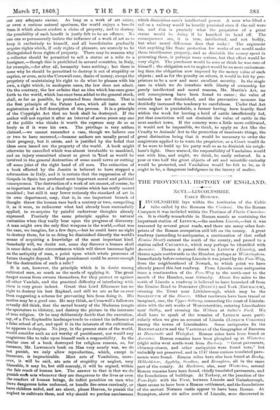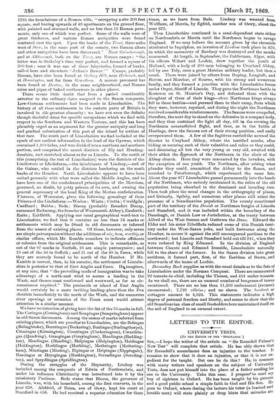THE PROVINCIAL HISTORY OF ENGLAND.
XCVL—LINC OLNSHI RE.
EARLY HISTORY.
I1NCOLNSHIRE lays within the , territories of the Celtic tribe called by the Romans the Coritani. On the Roman Conquest it was included within the Province of Flavia Cassariensis. It is chiefly remarkable in Roman annals as containing the important station of LINDUM,—the modern Lincoln,—but it was traversed by several great roads, and there are many other footprints of the Roman occupation still left on the county. A great roadway (according to antiquaries, a continuation of that called Ermine Street) entered the south of the county, and passed to a station called CAUSENN.E, which may perhaps be identified with Ancaster. Thence it passed direct to LIND UM (Lincoln), and thence again northwards to the Humber, perhaps at IVinteringliam. Immediately before entering Lincoln it was joined by the Foss-Way, from the neighbourhood of Newark, to which point we have already traced this last roadway. From Lincoln some antiquaries trace a continuation of the Foss-Way to the north-east to the mouth of the Humber, near Grimsby. About five miles to the north of Lincoln a roadway is believed to have branched off from the Ermine Road to Doncaster (DANuN) and York (EnuaAcum), crossing the Trent near Littleborough, which may be the S EGELOC UM of the Rinera. Other roadways have been traced or imagined, one, the Upper Saltway, connecting the coast of Lincolnshire with the salt works of Worcestershire, entering Lincolnshire near Saltby, and crossing the Witham at Salter's Ford. We shall have to speak of the remains of LINDUM more particularly when we give an account of Lincoln (LIND UM COLONIA) among the towns of Lincolnshire. Some antiquaries fix the BANNOVALLUM and the VAixonks of the Geographer of Ravenna at Horneastle and Wainjleet. Roman coins have been found at Ancaster. Roman remains have been ploughed up at Wintertou (eight miles west south-west from Barton). "Great pavements, chimney-stones, and other antiquities were found here," but unluckily not preserved, and in 1747 three curious tesselated pavements were found. Roman relics have also been found at Roxby, Hibbaldstow, Appleby, Sandlon, and Broughton, all in the same part of the county. At Horkstow, also, near Winte, ton, several Roman remains have been found, chiefly tesselated pavements, and the foundations of buildings. At Torksey, at the junction of the Foss-Dyke with the Trent, between Lincoln and Gainsborough, there seems to have been a Roman settlement, and the foundations of the ancient Norman castle appear to have been Roman. At Scampton, about six miles north of Lincoln, were discovered in 1795 the foundations of a Roman villa, "occupying a site 200 feet square, and having upwards of 40 apartments on the ground floor, with painted and stuccoed walls, and no less than 13 Roman pavements, only one of which was perfect. Some of the walls were of great thickness, and various Roman antiquities were found scattered over the spot. Upon the banks of the Trent, three miles west of Stow, in the same part of the county, two Roman altars and other antiquities have been discovered." Near Gainsborough, and at Alkborough, both on the Trent, are Roman camps ; "the latter was in Stukeley's time very perfect, and formed a square of 300 feet ; near it was one of these labyrinths, formed of banks, called here and elsewhere ' Julian's Bower." Camps, probably Roman, have also been found at Gedney Hill, near Holbeach, and at Honnington, not far from Grantham. A mosaic pavement has been found at Denton, in the same neighbourhood, and Roman coins and pipes of baked earthenware in other places.
There seems little doubt that from a period considerably anterior to the ordinary dates assigned to the Saxon conquests, Low-German settlements had been made in Lincolnshire. The history of all these settlements in the eastern parts of Britain is involved in tlie greatest obscurity ; we have not even the definite though doubtful dates for specific occupations which we find with respect to the Southern and Western Teutons, and this has been plausibly urged as an argument for the greater antiquity and long and gradual colonization of this part of the island by settlers of that race. The south part of Lincolnshire we find included at the epoch of our earliest information in the land of the Gyrwas, which contained 1,200 hides, and was divided into a northern and southern portion, and comprised the marsh districts of Ely and Huntingdonshire, and stretched almost as far as Lincoln. To the north of this (comprising the rest of Lincolnshire) were the districts of the Lindisware or Undisfaras,—the inhabitants of Lindsey,—and of the Gainas, who settled in the districts bordering on the south banks of the Humber. North Lincolnshire appears to have been united generally with what were called the Middle Angles, and to have been one of the confederated principalities of the Mercians, governed, no doubt, by petty princes of its own, and owning the general supremacy of the head King of the Merian confederation. Florence, of Worcester, gives the following genealogy of these Princes of the Lindisfaras :—Woden ; Winta ; Cretta ; Cweldgils ; Caedbaed ; Bubba ; Beda ; Biscop (probably Benedict Biscop, surnamed Baducung, the founder of Wearmouth Abbey), Eanferth ; Eatta ; Ealdfrith. Applying our usual geographical word-test to Lincolnshire, we find that it contains no less than 76 marks or settlements which may be fdund in old documents or inferred from the names of existing places. Of these, however, only seven are simple patronymics without the additions of wic, ham, worthig, or similar affixes, which Mr. Kemble considers to indicate offshoots or colonies from the original settlements. This is remarkable, as out of the 97 marks in Norfolk, 24 are simple patronymics ; and 15 out of the 56 in Suffolk ; and 21 out of the 48 in Essex, while they are scarcely found to be north of the Humber. If Mr. Kemble is correct, then, in his surmise, the settlement of Lincolnshire is posterior to that of East Anglia and Essex. Thlimagines, at any rate, that "the prevailing mode of immigration was to take advantage of a north-east wind to secure a landing in the Wash, and thence coast southward and westward, as far as circumstances required." The peninsula or island of East Anglia would certainly be a more inviting landing-place than the Fen districts immediately to the north of the Wash, and the numerous river openings or estuaries of the Essex coast would attract attention in a similar manner.
We have no intention of giving here the list of the 76 marks in full. The Coringas (Corringham) and Sempingas (Sempringham) appear in old Saxon documents. Among the names of marks inferred from existing places, which are peculiar to Lincolnshire, are the Bolingas (Bolingbroke), Beccringas (Beckering), Buslingas (Buslingthorpe), Cirmingas (Kirmington), Coceringas (Cockerington), Cwaedringas (Quadring), Graegingas (Grayingham), Haedingas (Reddington), Headingas (Heading), Helpingas (Ffelpington), Holdingaa (Holdington), Horblingas (Horbling), Methringas (Metheringham), Mintingas (Minting), Ripingas or Hripingas (Rippingale), Ruscingas or Hrysgingas (Ruskington), Screadingas (Scredingten), and Sprydlingas (Spridlington).
During the struggles of the Heptarchy, Lindsey was included among the conquests of Edwin of Northumbria, and under his influence Christianity was introduced into it by the missionary Paulinus. Bede states that Blecca, the governor of Lincoln, was, with his household, among the first converts, in the year 628. Alchfrid, of Deira, son of Oswy, kept his court at Stamford in 658. He had received a superior education for these times, as we learn from Bede. Lindsey was wrested from Wulfhere, of Mercia, by Egfrid, another son of °awn about the year 673.
Thus Lincolnshire continued in a semi-dependent state either on Northumbria or Mercia until the Northmen began to ravage England. If we may believe the account given by the chronicle attributed to Ingulphus, an invasion of Lindisse took place in 870, in which the monastery of Bardney was destroyed and the monks massacred. At length, in September, the Ealderman, Algar, with his officers Wibert and Leofric, drew together the youth of Holland, with a body of 200 men belonging to Croyland Abbey, led by one Toly, once a great Mercian military leader, but then a monk. These were joined by others from Deping, Langtoft, and Boston, and Morchar, of Bourne, with his strong and numerous family, and they formed a junction with the Lincolnshire forces under Osgot, Sheriff of Lincoln. They gave the Northmen battle in Kesteven on St. Maurice's Day, and defeated them with the slaughter of three of their kings—three Northman kings always fell in these battles—and pursued them to their camp, from which they were, however, repulsed, and during the night the Northmen received considerable reinforcements. The Saxons were compelled, therefore, the next day to stand on the defensive in a compact body, and they thus sustained the fight all day, till in the evening the Northmen counterfeited flight, and thus, as in the battle of Hastings, drew the Saxons out of their strong position, and easily overpowered them. A few of the fugitives carried the news of the disaster to Croyland Abbey, where the terrified monks, after hiding or securing such of their valuables and relics as they could, and dismissing all but the very young or very old, awaited with their abbot the frpproach of the Northmen in the choir of the Abbey church. Here they were massacred by the invaders, with the exception of one youth. The Northmen, after seizing what plunder they could, committed the Abbey to the flames, and marched to Peterborough, which experienced the same fate. About the year 877 Lincolnshire passed permanently into the hands of the Northmen, who entirely recolonized it, the relics of the old population being absorbed in the dominant and invading race. Then took place the usual changes in the orthography of places, and Grimsby, Spilsby, and numerous other places still attest the presence of a Scandinavian population. The county constituted part of the territory of the Danish or Northman burghs of Lincoln and Stamford, and it was included within the boundary of the Daneleagh, or Danish Law or Jurisdiction, at the treaty between Alfred of the West Saxons and Gnthrum the Dane. Edward the Elder and his sister Ethelflecla reduced some of this Danish territory under the West-Saxon yoke, and built fortresses along the Humber, to secure it against the still unconquered portions to the northward ; but Lincoln and Stamford held out till 941, when they were reduced by King Edmund. In the division of England between Canute and Edmund Ironside, Lincolnshire naturally fell to the share of the former. In the Saxon division into great earldoms, it formed part, first, of the Earldom of Beorn, and afterwards of the house of Leofric.
Doomsday Book supplies us with the usual details as to the fate of Lincolnshire under the Norman Conquest. There are enumerated 92 tenants-in-chief, including the Thanes, and 414 under-tenants. As we shall see, there are an unusual number of burgesses of towns mentioned. There are no less than 11,503 sochemanni (socmen) enumerated ; 7,723 villeins; and no slaves. The bordarii or cottagers amount to 4,024. This statements indicates a high degree of personal freedom and liberty, and seems to show that the old Scandinavian class of small freeholders here maintained itself on the soil of England to an unusual extent.



































 Previous page
Previous page